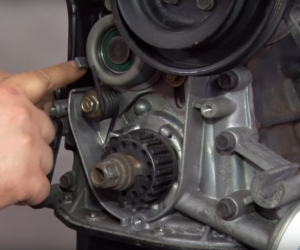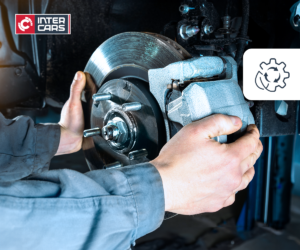The automotive market in Poland changes rapidly every single month, or even every single week we are informed about new branches of distributors openings in the whole country. We all wonder is there a limit? Where does the capacity of our automotive market end? How long is it going to last? Who loses and who profits? Where is the margin? The answer to those questions definitely is not easy. However, I do hope that this report will bring you closer to the automotive market relations in Poland. The value of auto-parts market still continues to grow, although slower than one may assume by observing dynamic changes in the automotive market. In 2002, the value increase has been estimated to the level of 10 percent. Last year, we could assume a few percent up growth, even though the value of zloty has meaningly increased mainly because its great decrease in comparison to euro.
How much is the aftermarket worth in Poland?
In order to estimate the value of auto-parts (passenger and van) market in Poland, we might start from the amount of visits that drivers pay to workshops as well as from the average cost of having a car repaired. Using the recent data on the topic and on market segmentation, I assumed that the value of automotive market in 2003 reached the level of 3 billion zloty
(645 millions euro). Counting in euro currency, it is barely few percent more than in 2002. But yet, the increase of rate of euro exchange and most auto-parts” prices increase that goes with it, has caused a situation in which last years automotive market value counted in zloty currency has been about 20 percent higher comparing to the year 2002.
Comparing a list of companies, which were used in order to make all analysis, we can observe few interesting changes. What might have caused them?
There are few new firms that definitely deserved to appear on the automotive market list. Keep in mind that this report considers the results achieved by the biggest distributors of auto parts for passengers cars and delivery vans segments only. The companies not included in following analysis: specializing in parts for trucks or specializing only in parts for Eastern cars. The Auto Art company has not been included in this report, because the latest news about their bankruptcy.
I did enclose Polsam Company to this report, because of its great scale of turnovers, although in western car parts segment the company has just started its activity. Another news on the list became Auto ABC. The company develops so well that it deserves to appear on the market players list. Traditionally, in my report, I also include total turnovers of buying groups. In the descriptive section however, I refer to each single member of a group individually.
Very important event that took place in a polish automotive market and definitely should be recognized is the fall of one of distributors.
There are at least two reasons why it is essential to return to the Confex AB case. Firstly, the size of automotive market, in which the company had worked.
Secondly, it is a huge auto-parts warehouse that is going to be on sale soon. Admittedly, the assortment gathered in the stock in small amount belongs to the A group (of the most popular references), nevertheless, the value of this stock in purchasing prices is close to over a 12,5 millions zloty (2,6 millions euro) and the amount of auto-parts is over 400 thousand items. This whole stock can hit the market on real low prices causing quite confusion.
In the Results Table there is a supplementary column related to margin of the companies.
We observe this great fascination with turnovers scale. Some companies that are being pressured by suppliers, long time ago have crossed the boundaries of rationality (common sense) in giving away discounts everywhere they can. I included that additional column to the table, which shows graphically main trends in changes of margins level.
Generally, margins topic is a delicate one. There is one thing that I am sure of. This fascination with turnovers has shaded the most important target of all companies- that is a profit. It must have been really bad, if majority of companies, which appear in this report, confirm the fall of margin officially. Somebody has to be first to finally stop this discounts- avalanche. If not, there will be much more companies dropping out of the market.
From the suppliers point of view, there is also another problem – of unpaid factures. Let us go on – suppliers financial departments watch the market much more cautiously stiffening the terms offered. Now, only about one percent loss of margin, for those companies which are included in the report, indicates a loss up to 18 millions zloty (3,8 millions euro). The data I was allowed to use, confirms that this amount was actually much higher.
So, what are the main reasons for margins decrease?
One may bring up few examples of producers, whose products in distributors companies generate great turnovers and costs only, but profits could be generally forgotten. The guilt lies on both sides: producers as well as distributors, so it is important for them to negotiate some kind of margins protection models in order to start earning money. Logic suggests that now comes the time in which when analyzing offers, the main reason for choosing a particular producers offer would be a possibility to earn money. Sale with no profit makes no sense. All the more, the distribution costs continue to grow, because the automotive market itself requires constantly improved services for workshops and wholesalers.
In case of the body parts group, the main reason for margins decrease lies in law regulations concerning insurance.
In order to maintain objectiveness, it is appropriate to point out another reason for margins decrease. It is a great increase of share in total distributional turnovers of low margins products such as tires or batteries. Up till today, those products have been sold purely by specialized companies.
]1[
Those strict numbers gathered in report do not provide the whole information. How should one interpret data, provided in the table above, which refers to turnovers as well as shares of each particular company?
Firstly, let me explain one issue- reviewing the content of a table, please do concentrate on the column showing estimated turnovers” increase value. I did not insert a percentage of turnovers purposely, because I did not intend to mislead a reader. For, it is much easier to attain great percent increase when a company has little turnovers. It is much more difficult to do so when a company has great turnovers.
Inter Cars recorded the biggest turnover again. In total, it turned out to be 445 million zloty (95,7 million euro) along with very impressive sales increase coming up to 126 million zloty (27,1 million euro). The turnovers increase was therefore much greater than a yearly turnover of few companies included in this report. At the same time, this distributor obtained one of the finest proportional increases of turnovers out of every single company mentioned in this report. This impressive result has been achieved thanks to rapidly developing and very well-organized branches in Poland. One of the most interesting solutions incorporated by the company is a smart organized program called “Fleet”. Its main purpose is to guarantee workshops loyalty towards their distributor. Certainly, it has contributed to the companies great results effectively.
Margins fall that has been recorded, was caused by a meaningful increase of share in sales of low margins parts such as tires, batteries, but also by partial adjustment to competitors price lists.
AD Polska still does record a significant sales increase of auto-parts assigned to western cars. It has let to survey large sales decrease of auto-parts to eastern cars. These decreases are quite natural and they become a result of shrinking of that particular markets fragment. The other thing that composed to the company”s great result was also an integration of few new partners such as Auto Land, Labijak, Pala, Carsmot. At the same time, AD Polska still develops workshops net under a common trade name AD Services. The extension of this net grows a bit slower than other competitive nets. However, when you observe it from aside, you might get an impression that workshops included in the net had been carefully chosen, which in the long distance strategy might turn out to be beneficial. The turnover of the whole group AD Polska in the year 2003 equals 325 million zloty (69,9 million euro). When it comes to elaborate margin, it does differ among each particular member of this group. Those, who specialize in auto-parts sales for eastern cars only, might have expected a margins increase in case of smaller companies dropping out of the automotive market. This assumption however, proved to be wrong. Small companies fighting for survival do accept extremely low margin, concentrating on costs reduction and making the quality of services much worse.
Fota is beyond doubt the second in size distributive company in auto-parts market in Poland. In the Results Table, it occurs on third position. Please, do keep in mind that AD Polska consists of eight companies strictly cooperating with each other. The auto-parts sales increase in the year 2003 Fota did attain thanks to net extension of its own branches and Lider Serwis workshops, which are nearly about 580 by now. One could assume that launching a new private brand Kager did cause a margins increase of Fota Company. For the closer attention definitely deserve events such as technical trainings organized along with auto-parts” producers and Mechanic of the Year contest. It does provide not only educational but also trading values, because it entices new customers.
More information about first three distributors and other are in the full version of the report 2003.
All companies put together, that are included in this report, have recorded about 30% of turnovers increase in the year 2003 proportionally to the year 2002. The main problem that has occurred turned out to be decreasing margin, which might become a disturber for some still developing companies.
Analyzing the results attained by particular companies, one question needs to be asked: who loses markets shares if almost everybody profits?
Distributors confronted in the report, do grow at the cost of companies that do import single trade groups, limit assortment, companies which are not adjusted to extremely demanding automotive market. Also distributors develop thanks to those companies which drop out of the market such as Confex AB. Speculations that the market would be soon dominated by enlarging selling groups as well as by large companies that incorporate smaller ones, are now being confirmed. A good example showing how difficult an automotive market is, could be withdrawal of Summit Auto Poland that belonged to Summit Auto Group. After a year of huge investments in warehouse, staff, trainings, logistics, the maximum monthly turnovers equaled about 280 thousand zloty (60 thousand euro). Obviously, withdrawal of secondary market does not mean that the company quits every activity in the market. It still works in OES segment. The company also is a Ford dealer.
]2[
Is it possible to estimate a share of each particular company in the market?
Polish automotive market is varied and it is divided between the whole set of small companies. Apparently, it seems that if we know its value and if we could estimate the turnovers of particular companies, we also could calculate their shares. However, shares that are being established this way cannot be a precise indicator. Therefore, in the Results Table, there has appeared an additional column divided into products groups and market segments in which those companies specialize. Signatures used (E, P, T, W, Es, J; see a legend) indicate those products groups, which are significant in view of turnovers scale of particular distributors.
]3[
Some companies sell auto-parts to western and eastern cars, some others to passengers cars and additionally to trucks, some else specialize in Japanese, French or Italian cars segment only. One cannot forget that different distributors deal with export with changeable intensity, which has an influence on a real portrait of shares in polish market. In conclusion, reliably, we could compare market shares only between some groups of products for particular car segments.
But still, if we did calculate these shares not guiding the products groups or cars segments, how would the market look like?
The result of summing up all the shares of all companies clearly shows the direction, in which polish market aims. In the year 2000 about 38% of market did belong to distributors described in this report. Today, it is about 60%. Thereby, other companies that had 62% of shares in the year 2000, occurred at the level of 40% in the year 2003.
]4[
It is important to keep in mind that beyond subjects placed in the table, there is still a number of healthy developing and extending regional companies such as Inter Parts, Auto Gama, Auto Zatoka, as well as specialists as Jadexim, or Intervito. Their turnovers are much lower than those of the leaders, but also the market, in which they work, is much smaller. In the years to come, the market will be divided between nationwide distributors and strong regional distributors. It is possible that regional distributors and specialists would seek an opportunity to integrate and to unify with other selling groups making the market more consolidated. Workshops however, willing to thank for offered support, and being encouraged by loyalty programs, will start to cooperate strictly with administrators of net services.
Alfred Franke






Komentarze